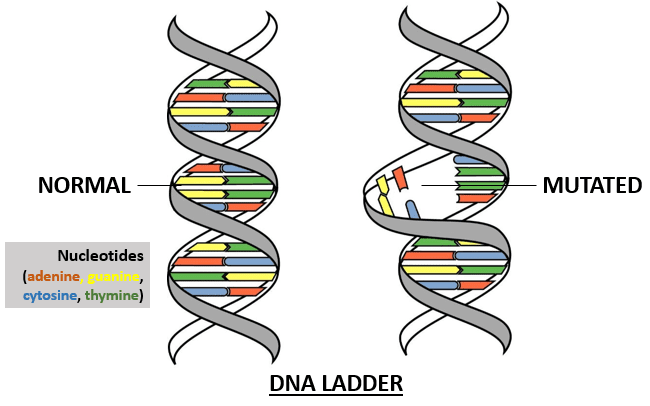In molecular biology and genetics, mutations are changes in a genomic sequence: the DNA sequence of a cell’s genome or the DNA or RNA sequence of a virus. They can be defined as sudden and spontaneous changes in the cell.
Mutations are caused by radiation, viruses, transposons and mutagenic chemicals, as well as errors that occur during meiosis or DNA replication. They can also be induced by the organism itself, by cellular processes such as hypermutation.
Mutation can result in several different types of change in sequences; these can either have no effect, alter the product of a gene, or prevent the gene from functioning properly or completely.
Studies in the fly Drosophila melanogaster suggest that if a mutation changes a protein produced by a gene, this will probably be harmful, with about 70 percent of these mutations having damaging effects, and the remainder being either neutral or weakly beneficial.
Due to the damaging effects that mutations can have on genes, organisms have mechanisms such as DNA repair to prevent mutations.
Mutations can involve large sections of DNA becoming duplicated, usually through genetic recombination.
These duplications are a major source of raw material for evolving new genes, with tens to hundreds of genes duplicated in animal genomes every million years. Most genes belong to larger families of genes of shared ancestry.
Novel genes are produced by several methods, commonly through the duplication and mutation of an ancestral gene, or by recombining parts of different genes to form new combinations with new functions.
Changes in chromosome number may involve even larger mutations, where segments of the DNA within chromosomes break and then rearrange.
In evolution, the most important role of such chromosomal rearrangements may be to accelerate the divergence of a population into new species by making populations less likely to interbreed, and thereby preserving genetic differences between these populations.
Nonlethal mutations accumulate within the gene pool and increase the amount of genetic variation.
The abundance of some genetic changes within the gene pool can be reduced by natural selection, while other “more favorable” mutations may accumulate and result in adaptive changes.
For example, a butterfly may produce offspring with new mutations. The majority of these mutations will have no effect; but one might change the color of one of the butterfly’s offspring, making it harder (or easier) for predators to see.
If this color change is advantageous, the chance of this butterfly surviving and producing its own offspring are a little better, and over time the number of butterflies with this mutation may form a larger percentage of the population.
Read Also : Plant Poisoning of Livestock and Control Measures
Neutral mutations are defined as mutations whose effects do not influence the fitness of an individual. These can accumulate over time due to genetic drift.
It is believed that the overwhelming majority of mutations have no significant effect on an organism’s fitness. Also, DNA repair mechanisms are able to mend most changes before they become permanent mutations, and many organisms have mechanisms for eliminating otherwise permanently mutated somatic cells.

Causes of Mutation
Two classes of mutations are spontaneous mutations (molecular decay) and induced mutations caused by mutagens.
1. Spontaneous mutation
Spontaneous mutationson the molecular level can be caused by;
Tautomerism – A base is changed by the repositioning of a hydrogen atom, altering the hydrogen bonding pattern of that base resulting in incorrect base pairing during replication.
Depurination – Loss of a purine base (A or G) to form an apurinic site (AP site).
Deamination – Hydrolysis changes a normal base to an atypical base containing a keto group in place of the original amine group. Examples include C → U and A → HX (hypoxanthine), which can be corrected by DNA repair mechanisms; and 5MeC (5-methylcytosine) → T, which is less likely to be detected as a mutation because thymine is a normal DNA base.
Slipped strand mispairing – Denaturation of the new strand from the template during replication, followed by renaturation in a different spot (“slipping”). This can lead to insertions or deletions.
2. Induced Mutation
Induced mutationson the molecular level can be caused by:
- Chemicals
- Hydroxylamine NH2OH
- Base analogs (e.g. BrdU)
- Alkylating agents (e.g. N-ethyl-N-nitrosourea)
These agents can mutate both replicating and non-replicating DNA. In contrast, a base analog can only mutate the DNA when the analog is incorporated in replicating the DNA.
Each of these classes of chemical mutagens has certain effects that then lead to transitions, transversions, or deletions.
Agents that form DNA adducts (e.g. ochratoxin A metabolites).
DNA intercalating agents (e.g. ethidium bromide).
DNA cross linkers.
Oxidative damage
Nitrous acid converts amine groups on A and C to diazo groups, altering their hydrogen bonding patterns which leads to incorrect base pairing during replication.
Radiation
Ultraviolet radiation (nonionizing radiation). Two nucleotide bases in DNA – cytosine and thymine – are most vulnerable to radiation that can change their properties. UV light can induce adjacent pyrimidine bases in a DNA strand to become covalently joined as a pyrimidine dimer.
UV radiation, particularly longer-wave UVA, can also cause oxidative damage to DNA. Mutation rates also vary across species. Evolutionary biologists have theorized that higher mutation rates are beneficial in some situations, because they allow organisms to evolve and therefore adapt more quickly to their environments.
For example, repeated exposure of bacteria to antibiotics, and selection of resistant mutants, can result in the selection of bacteria that have a much higher mutation rate than the original population (mutator strains).
Read Also : Benefits of Forest and Wildlife Resources
Frequently Asked Questions
We will update this section soon.

